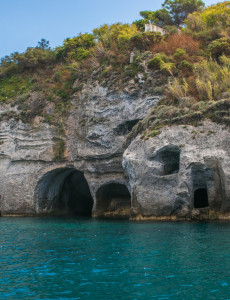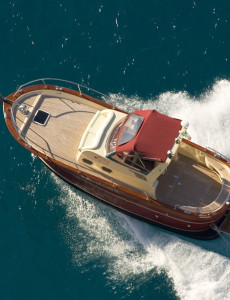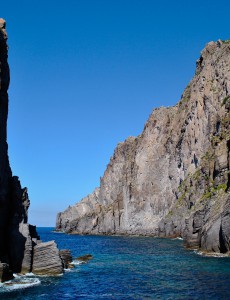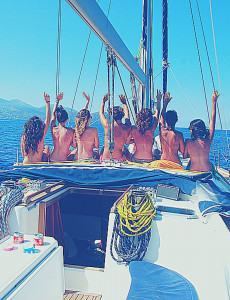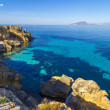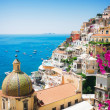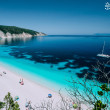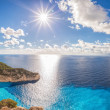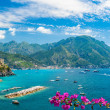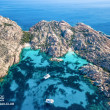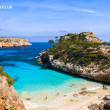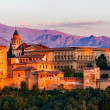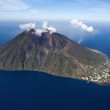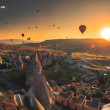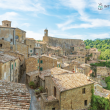
Amalfi Coast
Amalfi from the Sea: Where Rock, Light and Silence Meet
Approaching Amalfi from the sea is like crossing into another dimension — one where time clings to cliffs and colors change with the tides. The coast appears suddenly, carved into dramatic verticality, where steep limestone ridges tumble into the Tyrrhenian in layers of silver and green. The scent of citrus hangs in the breeze, mingled with salt and the distant hum of shore life. Along the coastline, seabirds glide across rising currents, and the occasional school of anchovies flickers beneath the surface like living light.
This part of Italy doesn't gently unfold — it rises, imposes, demands attention. The shoreline is jagged and unpredictable, stitched together by vertical terraces and hidden groves. Wild rosemary and fig trees cling to impossible ledges, and small inlets glisten like secrets in the rocks. Amalfi is not just a place — it is a vertical stage, a sensory cascade where every movement of air and shadow tells a different story.
Waking early on the water near Amalfi means watching the light shift from soft blue to golden amber, revealing fine lines in the rock like age on a face. In the distance, domes and bell towers shimmer through morning haze, echoing the town’s layered identity — once a powerful maritime republic, now a quieter echo of its former grandeur. This duality — of grand history and intimate present — is what gives Amalfi travel its unmistakable rhythm.
One of the clearest insights comes not from guide books but from simply floating, watching: here, beauty isn’t static. It transforms constantly — with the wind, the cloud cover, the tides. Amalfi holidays aren’t built on lists of sights to see, but on the ability to notice — a path in the cliff, the color of the sea at noon, a hawk riding thermals above the town. A proper Amalfi guide begins with the senses, not logistics.
Why visit Amalfi? Because it’s one of the few places where the landscape doesn’t just surround you — it speaks to you, slowly, from every curve of stone and light.
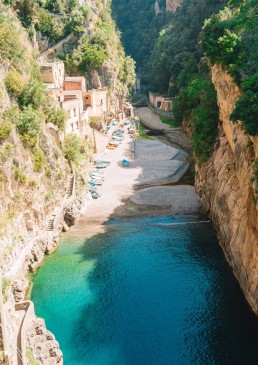

Coastal Drift: Discovering Amalfi from the Waterline
To sail along the coastline of Amalfi is to trace a living sculpture carved by wind and time. The cliffs rise like frozen waves, covered in terraces of lemon groves and shaded by medieval watchtowers. From the sea, the land reveals its most intimate face — one that hides from the road above and only shows itself to those moving slowly, deliberately, from cove to cove. Sailing Amalfi isn’t about distance — it’s about immersion.
The shoreline here shifts constantly in light and tone. Early mornings paint the rock in cool silver, while afternoons bring golden reflections that seem to melt the mountains into the sea. Small, hidden beaches appear between sharp stone outcrops, unreachable by foot and perfect for a pause or a swim. Just off the coast near Santa Croce or Conca dei Marini, the water deepens to an impossible blue. These are ideal places for Amalfi snorkeling, with vertical underwater cliffs that mirror the ones above.
One of the most rewarding ways to explore the region is through an Amalfi catamaran charter, which provides a wide, stable platform for taking in the views — or simply drifting without hurry. For those seeking more privacy or control, a skipper charter Amalfi lets you tailor your route with the guidance of someone who knows every curve of the coast. Whether mooring off the shores of Atrani for lunch or navigating toward the Furore Fjord at sunset, each day becomes a flowing sequence of visual discoveries.
An Amalfi yacht charter is about freedom. No timetables, no crowds — just the movement of sails and sea, with the coastline constantly redrawing itself with every mile. And when the villages light up at night, seen from a quiet anchorage offshore, the experience turns poetic. This is the essence of an Amalfi sailing cruise: slow, sensual, elemental.
Is Amalfi good for sailing? Absolutely — not only for its navigable waters and protected bays, but because it offers a perspective that no viewpoint on land can match.
IntersailClub offers curated sailing routes that follow the rhythms of Amalfi’s coastline, granting access to hidden coves, cliffside villages, and the quiet beauty of the sea — all without ever setting foot in a crowd.

Tides of Tradition: Amalfi’s Coastal Heritage and Living Culture
Along the cliffs and harbors of Amalfi, the sea has always been more than a horizon — it has been the island’s lifeblood, the source of its wealth, threats, and inspiration. During the Middle Ages, Amalfi rose to prominence as one of the powerful Maritime Republics, its ships sailing as far as the eastern Mediterranean. Trade brought silks, spices, and ideas to this dramatic coastline, leaving behind not only prosperity, but a deeply layered legacy that still echoes in the streets and rituals of today.
You can feel the depth of Amalfi history in the Duomo’s Byzantine mosaics and the cloisters shaded with palms, or in the preserved documents of the Tabula Amalfitana, a maritime code that once guided sailors across the seas. Beyond monuments, the past lives on in everyday rhythms: processions to honor patron saints, the architecture of terraced fishing villages, and coastal customs that have resisted the passage of time.
Artisans in Amalfi still handcraft paper using medieval techniques, producing sheets of soft, fibrous texture known as bambagina. Along the coast, traditional songs once sung by fishermen continue to be played during local festivals. And in the kitchens, you’ll find dishes rooted in simplicity and seasonality — anchovies from Cetara, pasta with lemon zest, octopus stewed with olives — flavors that connect the table to the tides.
There’s a quiet truth in Amalfi life: that real culture isn’t curated, it’s lived. It’s in the conversations on stone stairways, the scent of bread baking near the marina, the clang of church bells softened by sea air.
Amalfi culture doesn’t scream for attention — it waits to be noticed, like the light shifting on a tile roof at dusk.
What cultural influences shape Amalfi's identity? A rich blend of seafaring tradition, Mediterranean trade, religious devotion, and humble daily rituals — all shaped by centuries of contact between land and water, east and west.
Wind, Light, and Sea: Understanding Amalfi’s Sailing Conditions
June is the hottest month in Havana with an average temperature of 27°C (81°F) and the coldest is January at 21°C (70°F) with the most daily sunshine hours at 11 in July. The wettest month is June with an average of 80mm of rain. The best month to swim in the sea is in August when the average sea temperature is 30°C (86°F).
Check all Statistics in AccuweatherAll destinations in Mediterranean Sea
-

-

-

-

-

-

-

-

-

-

-

-

-

-

-

-

-

-

-

-

-

-

-

-

-

-

